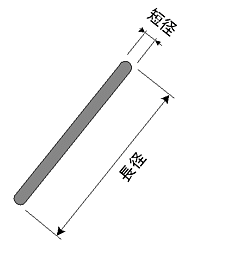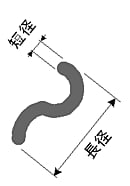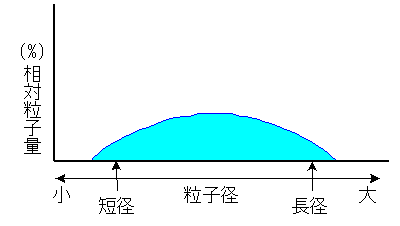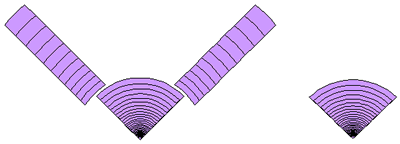Measurement of Acicular/Fibrous Particles
Particle size distribution is normally expressed as a particle amount (accumulation or frequency) against the particle size scale. Also, with the "laser diffraction/scattering method," the principle of measurement of laser diffraction particle size analyzers, the particle size distribution is obtained based on the light intensity distribution pattern of diffracted/scattered light that is calculated on the assumption that particles are spherical. So, particle size measurement is performed based on the assumption that particles are spherical at all times.
Well, then, what kind of results will be obtained when acicular or fibrous particles such as those shown in Figs. 1 and 2 are measured?

Fig. 1 Example of Acicular/Fibrous Particle (1)

Fig. 2 Example of Acicular/Fibrous Particle (2)
Starting with the conclusion first, the measurement results for the particle size distribution shown in Fig. 3 are obtained. These results assume that the particle group to be measured is made up of only particles of exactly the same shape and size. In this case, the particle size distribution obtained as the measurement result is a relatively broad distribution in which the minor and major diameters of the acicular/fibrous particles are almost equivalent to the lower and upper limits of the distribution.

Fig. 3 Particle Size Distribution When Acicular/Fibrous Particles Are Measured
This is because of two things. Firstly, the direction of the acicular/fibrous particles is considered random in the cell. And, secondly, even supposing that the direction of the particles is fixed to some extent, ultimately the diffracted/scattered light from more than one fixed direction is detected since the shape of the sensor on the SALD series for detecting diffracted/scattered light is a quarter of a circle as shown in Fig. 4.

Fig. 4 Shape of Forward Scattered Light Sensor Adopted on SALD Series (Left: for SALD-3100/2200/7000 Right: for SALD-300V/200V ER)
When a particle group contains acicular/fibrous particles of various shapes and sizes, the resulting particle size distribution ranges from the smallest minor diameter to the largest major diameter among these particles.
Accordingly, even with acicular/fibrous particles such as these, if the variance in shape/size of the particles contained in the particle group to be measured increases, the distribution range widens, and, alternatively, narrows if the variance decreases. Also, if the shape and size get larger (longer), the particle distribution overall shifts to the larger side, while if the shape and size get smaller (shorter), the particle distribution overall shifts to the smaller side.
Likewise, if the acicular/fibrous particles aggregate, the particle distribution overall shifts to the larger side, while, if the particles are successfully scattered, the particle distribution overall shifts to the smaller side. In other words, the scattered/aggregated state of the acicular/fibrous particles can be evaluated.
In this way, although laser diffraction particle size analyzers cannot measure the minor and major diameters of acicular/fibrous particles separately and cannot obtain each of their distributions, they are capable of obtaining important information relating to the properties of the particles.


